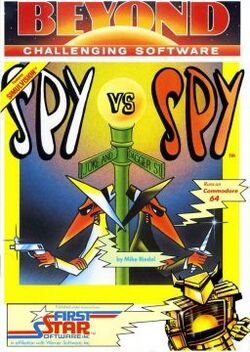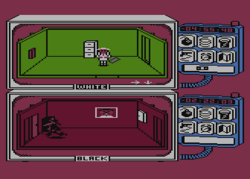Spy vs. Spy (1984 video game)
Topic: Software
 From HandWiki - Reading time: 4 min
From HandWiki - Reading time: 4 min
| Spy vs. Spy | |
|---|---|
 European Commodore 64 cover art | |
| Developer(s) | First Star Software Compile (PC-8801, X1) |
| Publisher(s) | Beyond Software (UK) Tynesoft (BBC, Electron) Wicked Software (Amiga, ST) Kemco (NES, GBC) Robots and Pencils (iOS) |
| Designer(s) | Original Version Michael Riedel [1] PC-8801, X1 Satoshi Fujishima |
| Programmer(s) | Commodore 64 Michael Riedel [1] Atari 8-bit Jim Nangano[1] PC-8801, X1 Takayuki Hirono[1] |
| Composer(s) | C64 Nick Scarim NES Hiroyuki Masuno PC-8801, X1 Masatomo Miyamoto |
| Platform(s) | Acorn Electron, Amiga, Amstrad CPC, Apple II, Atari 8-bit, Atari ST, BBC Micro, Commodore 64 Commodore 16, Game Boy, Game Boy Color, NES, Master System, PC-8801, X1, ZX Spectrum |
| Release | 1984
|
| Mode(s) | Single-player, multiplayer |
Spy vs. Spy is a video game written by Michael Riedel for the Commodore 64 and published by First Star Software in 1984. A port for the Atari 8-bit family was released simultaneously. It is a two-player, split-screen game, based on Mad magazine's long-running cartoon strip Spy vs. Spy, about the slapstick antics of two spies trying to kill each other with improbably elaborate traps and weapons.
It was ported to the Apple II, ZX Spectrum, Acorn Electron, Atari ST, BBC Micro, Commodore 16, Amstrad CPC, Amiga, Master System, Game Boy, Game Boy Color, and Nintendo Entertainment System.
Gameplay
The object of the game is to collect various secret items in a briefcase and exit the building through a door to the airport, either before the opposing player exits or before the timer runs out. While searching for the items, traps can be laid to take out the opponent (or the player himself, if careless). Each spy has a personal countdown timer which depletes by 30 seconds upon each death.
The arena is an embassy, constructed from a series of interconnected rooms laid out on a grid pattern. Higher levels have more rooms and therefore a larger play area. The spies can engage in hand-to-hand combat (achieved by wiggling the joystick or directional pad left and right or up and down when the spies are in proximity to each other) as well as place traps on the furniture and doors which occupy the playing area. These traps are triggered when a spy searches a piece of furniture or opens a booby trapped door, resulting in a cartoon-style animation showing the subject being shot, blown up, etc., and floating up to heaven as an angel.
Strategy is introduced by limiting the numbers of each trap a spy can use and by allowing the traps to be triggered by either spy. Some pieces of furniture also contain 'remedies' which match up to specific traps; these allow a trap to be defused, but can only be fetched one at a time.
Reception
Video magazine described it as "a rousing action-strategy contest" and praised the game's "excellent" graphics as "befit[ting] a game so rooted in a visual medium." The reviewer also noted that "no one has more successfully captured the original feel of the source nor offered a more satisfying result".[5] Ahoy! agreed in its faithfulness to the original, and praised both the simultaneous two-player and one-player options.[6] Antic called it "one of the most original and clever games for the Atari computers yet". The magazine praised the simultaneous two-player display and concluded, "I cannot recommend this game highly enough."[7] The ZX Spectrum version was rated number 20 in the Your Sinclair Official Top 100 Games of All Time.[8]
Computer and Video Games scored the Sega Master System version 90% in 1989[9] and 88% in 1990.[10]
The NES version sold 300,000 units in North America.[11]
Legacy
A remake including the original version was released for iOS in 2012, but is no longer available.
Two sequels to the original 1984 game were produced: Spy vs. Spy II and Spy vs. Spy III. The third game was also released for the IBM PC. These kept the basic gameplay while tweaking some core features.[12]
References
- ↑ 1.0 1.1 1.2 1.3 Hague, James. "The Giant List of Classic Game Programmers". https://dadgum.com/giantlist/.
- ↑ Jareske, Brent. "Spy Vs. Spy: NES Release – GamingRebellion". https://www.gamingrebellion.com/2014/12/spy-vs-spy-nes-release/.
- ↑ "Sega Mark III" (in ja). Sega. https://sega.jp/history/hard/segamark3/software.html.
- ↑ "Availability Update". Computer Entertainer: p. 08. October 1988. http://www.ataricompendium.com/archives/newsletters/video_game_update/computer_entertainer_oct88.pdf#page=08.
- ↑ Kunkel, Bill (February 1985). "Random Access: Spy vs. Spy". Video (Reese Communications) 8 (11): 35. ISSN 0147-8907.
- ↑ Fried, Greg (March 1985). "Spy vs. Spy". Ahoy!: pp. 33–34. https://archive.org/stream/Ahoy_Issue_15_1985-03_Ion_International_US#page/n31/mode/2upp. Retrieved 27 June 2014.
- ↑ Bernstein, Harvey (May 1985). "Spy vs. Spy". Antic: p. 81. https://archive.org/stream/1985-05-anticmagazine/Antic_Vol_4-01_1985-05_New_Super_Ataris#page/n79/mode/2up. Retrieved 8 January 2015.
- ↑ "Readers' Top 100 Games of All Time". Your Sinclair. September 1993.
- ↑ "Complete Games Guide". Computer and Video Games (Complete Guide to Consoles): 46–77. 16 October 1989. https://retrocdn.net/images/9/98/CompleteGuideToConsoles_UK_01.pdf#page=46.
- ↑ "Guide: Sega". Computer and Video Games (Complete Guide to Consoles: Volume IV): 108–10. November 1990. https://archive.org/details/Complete_Guide_to_Consoles_Volume_IV_1990_EMAP_Publishing_GB/page/n107/mode/2up.
- ↑ "Spy vs. Spy History". Archived from the original on September 9, 2007. https://web.archive.org/web/20070909053059/http://www.firststarsoftware.com/spyvsspy.htm. Retrieved March 16, 2023.
- ↑ Farrell, Andrew. "Spy vs Spy II Review". The Australian Commodore Review (Saturday Magazine Pty) 2 (7): 6. ISSN 0816-5874. OCLC 217544012.
External links
- Spy vs. Spy at SpectrumComputing.co.uk
- Spy vs. Spy at Lemon 64
- Spy vs. Spy at Atari Mania
- Video from the C64 version on archive.org
fr:Spy vs. Spy
 |
 KSF
KSF
